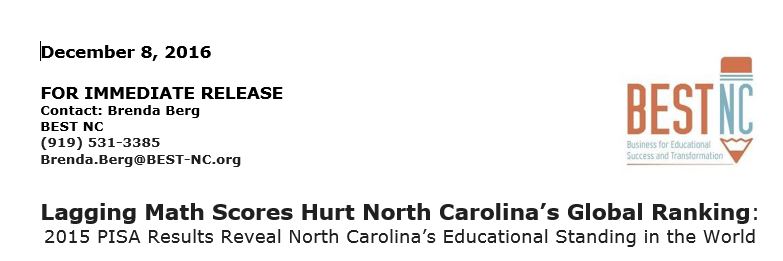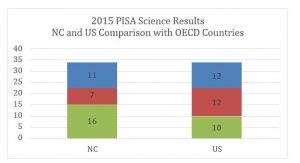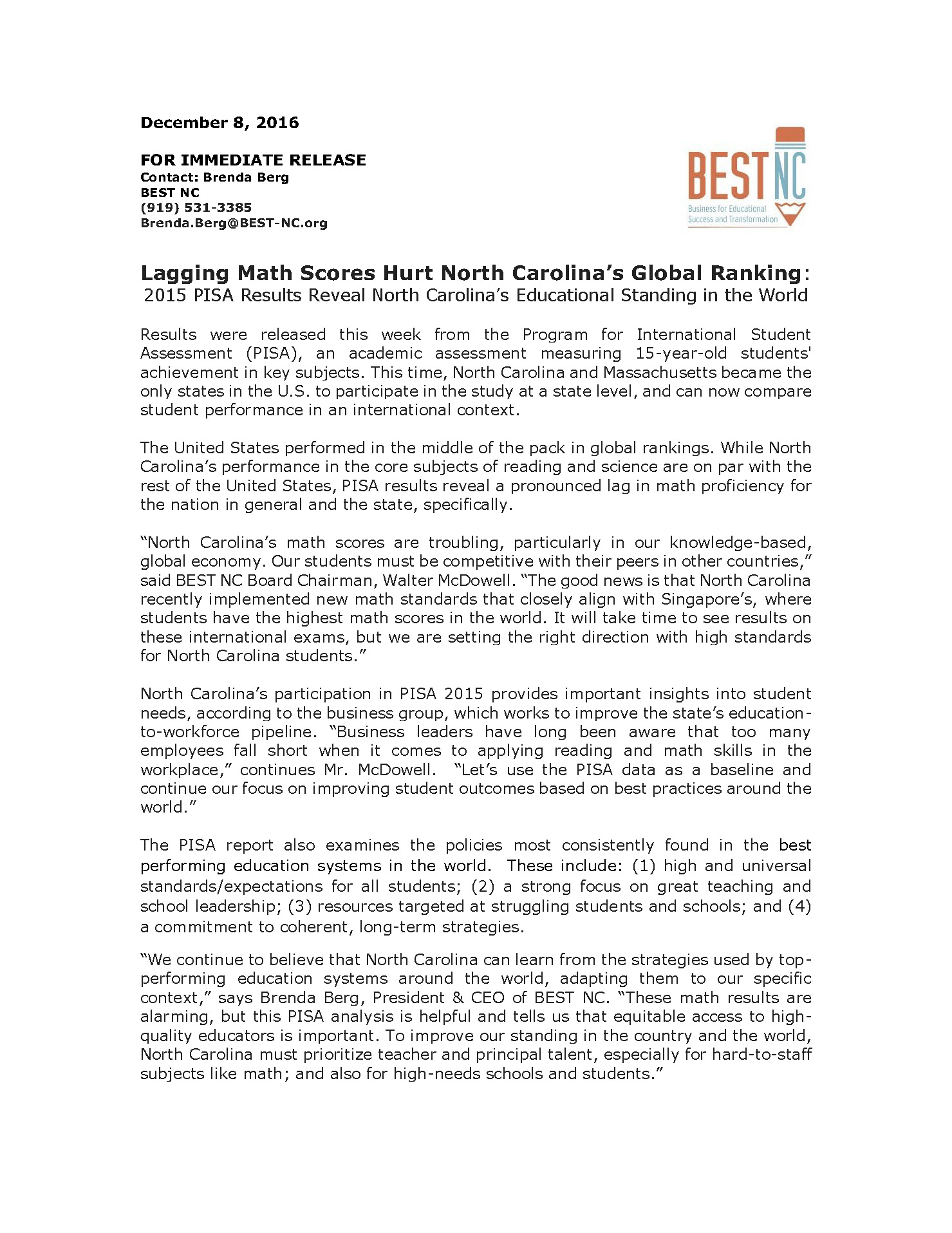
Results were released this week from the Program for International Student Assessment (PISA), an academic assessment measuring 15-year-old students’ achievement in key subjects. This time, North Carolina and Massachusetts became the only states in the U.S. top anticipate in the study at a state level, and can now compare student performance in an international context.
The United States performed in the middle of the packing global rankings. While North Carolina’s performance in the core subjects of reading and science are on par with the rest of the United States, PISA results reveal a pronounced lag in math proficiency for the nation in general and the state, specifically.
“North Carolina’s math scores are troubling, particularly in our knowledge-based, global economy. Our students must be competitive with their peers in other countries,” said BEST NC Board Chairman, Walter McDowell. “The good news is that NorthCarolina recently implemented new math standards that closely align with Singapore’s, where students have the highest math scores in the world. It will take time to see results on these international exams, but we are setting the right direction with high standards for North Carolina students.”
North Carolina’s participation in PISA 2015 provides important insights into student needs, according to the business group, which works to improve the state’s education-to-workforce pipeline. “Business leaders have long been aware that too many employees fall short when it comes to applying reading and math skills in the workplace,” continues Mr. McDowell. “Let’s use the PISA data as a baseline and continue our focus on improving student outcomes based on best practices around the world.”
The PISA report also examines the policies most consistently found in the best performing education systems in the world. These include: (1) high and universal standards/expectations for all students; (2) a strong focus on great teaching and school leadership; (3) resources targeted at struggling students and schools; and (4) a commitment to coherent, long-term strategies.
“We continue to believe that North Carolina can learn from the strategies used by top- performing education systems around the world, adapting them to our specific context,” says Brenda Berg, President & CEO of BEST NC. “These math results are alarming, but this PISA analysis is helpful and tells us that equitable access to high- quality educators is important. To improve our standing in the country and theworld, North Carolina must prioritize teacher and principal talent, especially for hard-to-staff subjects like math; and also for high-needs schools and students.”
PISA is coordinated by the Organization for Economic Cooperation and Development (OECD). This international study provides critical student achievement insights into how North Carolina high school students compare too the rstudentsaroundtheworld. ThePISAanalysisalsoexamineswhysomecountriesmayperformbetterthanothers. PISA 2015 assessed students’ science, reading, and math literacy in 71 cities, states and municipalities, including 35 OECD countries.
Internationally, eight out of 35 OECD countries outperformed North Carolina in reading, and 11 outperformed North Carolina students in science (13 countries performed worse in reading, while 16 performed worse in science). Amidst these middle-of-the pack rankings, the most concerning indicator is that North Carolina falls at the bottom of international rankings in math, with only four OECD countries performing worse.
A bright light for the U.S., and North Carolina in particular, is the increasing educational equity between more affluent students and those that are economically challenged. Historically, poverty has been a strong predictor of academic outcomes. However, from 2006 to 2015, disadvantaged U.S. students performed above expectations compared to other OECD countries. Excitingly, North Carolina has achieved an even better result. A student’s level of poverty was a 13% predictor of student performance across OECD countries. But in North Carolina, a student’s level of poverty only had a 9% influence. This is good news for North Carolina, as it suggests that, on average, we do a better job of providing equitable educational opportunities than other OECD countries.
# ##
About PISA 2015
Over 500,000 students took the PISA 2015 test globally, which aims to capture what students know toward the end of their formal schooling, and how well they can apply that knowledge more broadly. The assessment includes innovative approaches such as collaborative problem solving, breaking from the old model of rote memorization; with the ultimate goal of having students apply what they have learned in school to real-life situations.
Learn more about how the 2015 PISA results evaluates the quality, equity & efficiency of school systems around the globe here, with a summary here.
# # #
About BEST NC
BEST NCis a non-profit, non-partisan coalition of business leaders committed to improving North Carolina’s education system through policy and advocacy. We do this by convening a broad constituency; encouraging collaboration around a shared, bold vision for education; and advocating for policies, research, programs, and awareness that will significantly improve education in North Carolina.www.BEST-NC.org
Click here to view PISA Press Release PDF
[/vc_hidrop]
 [/vc_hidrop]
[/vc_hidrop] [/vc_hidrop]
[/vc_hidrop] [/vc_hidrop]
[/vc_hidrop]
[/vc_hidrop]


